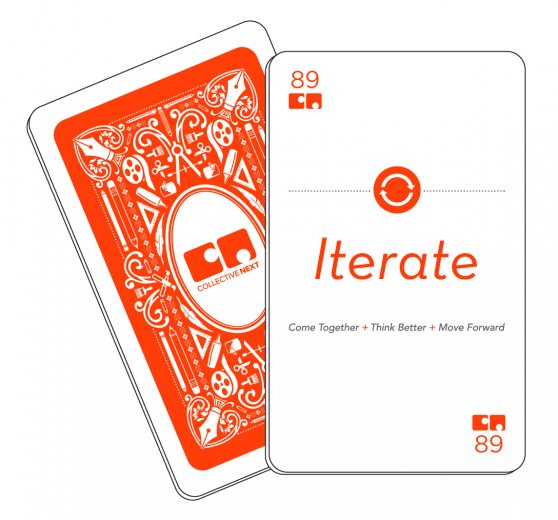This is one of a series of posts we’re running this summer about the Collective Next Cards.
Get Messy
It’s Saturday morning at Casa Sanchez and the kids and I are whipping up birthday breakfast for Daddy: pancakes! My three-year-old is “measuring” flour and buttermilk. My five-year-old is cracking eggs and shaking her shoulders to James Brown. Vigorous batter stirring ensues as I fire up the stovetop. The kids stop and stare as I ladle out enough batter for the first pancake and gently pour it into the hot skillet.
When the too-runny batter blob goes almost totally flat and starts smoking around the edges, my daughter raises an eyebrow. I turn down the heat and try to flip up the edge of the goo with my spatula. I manage to flip the hotcake, but when I do, it folds almost in half. The cooked side is blond, not the desired golden brown. “Mommy, that doesn’t look like a pancake I want to eat,” says my girl. “Don’t worry,” I reply. “This is just the first pancake. We have a lot more chances to get this right.”
The first pancake is always a mess. But that’s OK; it teaches you what you need to know about the second pancake, the third pancake, and so on. The important thing is to accept imperfection, learn, and keep going. (And have fun.)
Begin
Some days it feels like Professional First Pancake Maker should be my official job title instead of Art Director. It’s simple and true: In order to move forward you must begin. Much of the time, my job is to help groups and individuals begin.
When I am graphic facilitating, or scribing, my role is often to listen to a group of people think out loud, while quietly sketching a synthesized visual model or prototype of their ideas. If it’s messy, I know I’m on the right track. The perfect first iteration might just be a loose affiliation of blobs, arrows, and squiggles.
There is often a moment when someone in the audience looks up from the conversation and notices what I am doing and says, “Hey! That’s what we’re talking about.” There are sometimes little sighs of relief or gratitude, and then, “But wait, we need to just change this part…” And then they take the marker and they’re off. I love that.
Repeat
Iterate is just a fancy word for “repeat.” Apparently, “An endless source of amusement for programmers is the observation that the directions on shampoo, ‘Lather, rinse, repeat,’ are an infinite loop because there is no iteration variable” wrote Dr. Charles Severance, Professor of Information Science at University of Michigan. I code in my spare time, and it’s true: I find this endlessly amusing.
Our clients enlist us to help go beyond their entrenched infinite loops — tired patterns of thinking, talking, and working — and move forward. While there is certainly value in repetition (think: very clean hair, toned biceps, Gregorian chants), we at Collective Next are masters of and total geeks for the iteration variable.
We are always listening for shifts, divergence, and feedback, and using these to guide intelligent iteration. In collaborative design sessions, we layer the agenda with rounds of iteration in which problems and solutions are approached from multiple vantage points and tested against a wide variety of scenarios. We believe that this creates engagement, alignment, and vastly better solutions.
Ship
Shipping, or ending, is just as critical as beginning and iterating. As anyone who watches Project Runway knows, at some point you’ve got to be prepared to walk your idea down the runway. Short development cycles amplify creative intent and momentum. Whether you’re making a dress out of licorice or a stack of pancakes, writing your TED Talk script, or designing the next iPhone, know when to keep iterating — and when to call it done.
Image credits: The cards are designed by Evan Wondolowski; the three images in the text of this post are by Nathaniel Bellows.
Back








